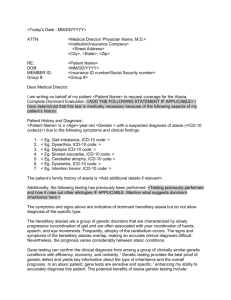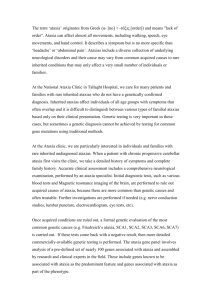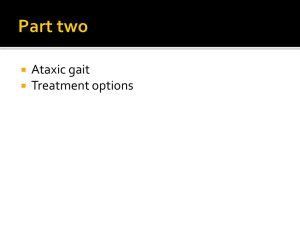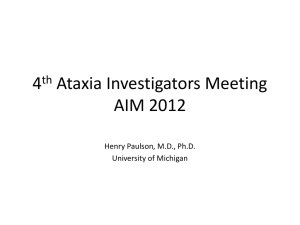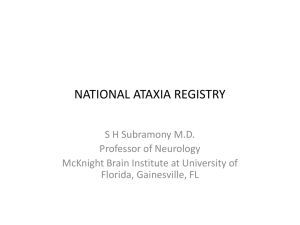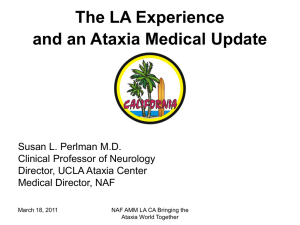Genetics and family planning
advertisement
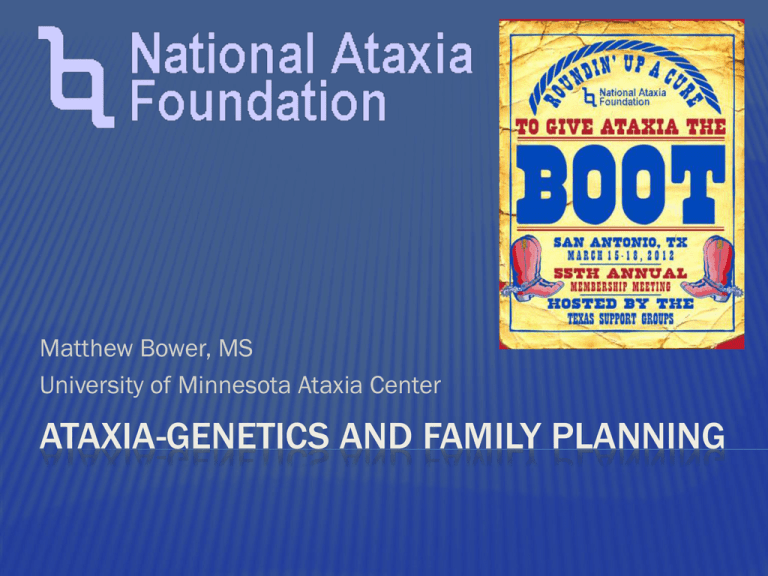
Matthew Bower, MS University of Minnesota Ataxia Center ATAXIA-GENETICS AND FAMILY PLANNING DISCLAIMER The information provided by speakers in any presentation made as part of the 2012 NAF Annual Membership Meeting is for informational use only. NAF encourages all attendees to consult with their primary care provider, neurologist, or other health care provider about any advice, exercise, therapies, medication, treatment, nutritional supplement, or regimen that may have been mentioned as part of any presentation. Products or services mentioned during these presentations does not imply endorsement by NAF. PRESENTER DISCLOSURES Matt Bower, MS, CGC The following personal financial relationships with commercial interests relevant to this presentation existed during the past 12 months: No relationships to disclose or list TAKE-HOME POINTS: Ataxia genetics are too complicated for a 30 minute talk! I will be speaking in broad generalizations Consult with your physician or genetic counselor about your specific questions TAKE HOME POINTS Plan ahead Many testing options require advance knowledge of your genetic status TAKE HOME POINTS Family planning decisions are personal decisions- there is no “right” answer. GENETICS REVIEW- DOMINANT INHERITANCE SCA1-36 (and counting!) These men are both affected with ataxia GENETICS REVIEW- DOMINANT INHERITANCE SCA1-36 (and counting!) Each of these siblings has an independent 50% risk GENETICS REVIEW- RECESSIVE INHERITANCE Friedreich, AOA1, AOA2, AT, and others These two sibilngs have ataxia GENETICS REVIEW- RECESSIVE INHERITANCE Both parents are carriers GENETICS REVIEW- RECESSIVE INHERITANCE These two siblings have a 2/3 (67%) carrier risk GENETICS REVIEW- RECESSIVE INHERITANCE Carrier risk for spouses depends on how common the ataxia is in the general population STEP 1- WHAT KIND OF ATAXIA IS IN MY FAMILY? Diagnostic testing- Testing someone with symptoms to figure out the type of ataxia in your family. This person may be you (if you have symptoms), or it may be another family member. Genetic testing is only accurate if the type of ataxia in the family is known. Important to obtain actual test results, if possible. STEP 2- WHAT IS MY GENETIC STATUS? In order to determine if your children may be at risk, it may be important to determine your own genetic status Dominant If ataxias you have symptoms, you could have diagnostic testing. If you are asymptomatic, you could have predictive testing. STEP 2- WHAT IS MY GENETIC STATUS? In order to determine if your children may be at risk, it may be important to determine your own genetic status Recessive Affected ataxias with the familial ataxia-diagnostic testing Biological relatives of affected individuals (carrier testing) Non-biological relatives of affected individuals (i.e. people who marry into the family) carrier testing STEP 3- WHAT ARE RISKS TO FUTURE CHILDREN? Dominant ataxias If you have the ataxia gene, your child will have a 50% risk (regardless of whether it is a boy or girl) If you did not inherit the ataxia gene, then your children are not at risk (i.e. does not skip generations). Recessive If ataxias both parents are carriers, the risk to each child is 25% (regardless of whether it is a boy or girl) STEP 4- WHAT ARE MY OPTIONS? Having children without any genetic testing Adoption / Foster parenting Pregnancy with prenatal diagnosis In vitro pregnancy with donor egg donor sperm In vitro pregnancy with genetic testing (preimplantation genetic diagnosis) PRENATAL DIAGNOSIS Definition- Genetic testing done during a pregnancy to determine if a fetus is affected with the familial ataxia Two procedures are available: Chorionic villus sampling (CVS) Amniocentesis AMNIOCENTESIS • Amniotic fluid is removed using a thin needle. • Cells from amniotic fluid can be tested for the familial ataxia • Generally done after 15 weeks gestation • Small risk of miscarriage (< 0.5%) CVS • Generally done 10-13 weeks gestation • Not as widely available as amniocentesis • Risk of miscarriage varies from center to centergenerally <1% INTRAUTERINE INSEMINATION WITH DONOR SPERM If the father is affected with a dominant ataxia, or a carrier of a recessive ataxia, patients can utilize a donor sperm sample Known unaffected relative Anonymous donor Does not require IVF procedures IN-VITRO FERTILIZATION Sperm and egg are mixed in a petri dish to create embryos. IN-VITRO FERTILIZATION WITH DONOR EGG IVF (all by itself) does not alter the risk for ataxia in children. If the mother is either affected with the ataxia, or is a carrier, couples can do in-vitro fertilization using an egg from a healthy donor. PRE-IMPLANTATION GENETIC DIAGNOSIS Embryos created through IVF One cell from each embryo is tested to determine if the embryo is “affected” with the familial ataxia. Only “unaffected” embryos are transferred to the uterus. PRE-IMPLANTATION GENETIC DIAGNOSIS (PGD) PRE-IMPLANTATION GENETIC DIAGNOSIS (PGD) Braude, P., et al., Preimplantation genetic diagnosis, Nature Reviews Genetics 3, 941–955 NON-INVASIVE PRENATAL DIAGNOSIS Fetal DNA is known to be in mother’s blood during pregnancy Tests have recently been developed to diagnose some specific fetal conditions from a maternal blood draw No risk of miscarriage Not yet available for conditions like ataxia. SUMMARY- WHAT ARE MY OPTIONS? Having children without any genetic testing Adoption / Foster parenting Pregnancy with prenatal diagnosis In vitro pregnancy with donor egg donor sperm In vitro pregnancy with genetic testing (preimplantation genetic diagnosis) STEP 5- WHAT IS RIGHT FOR ME? Does my future child’s ataxia status have any bearing on my decision to have children? Importance of being the biological mother/father Financial- will insurance cover the costs of procedures? Are there medical risks with some of these technologies Emotional investment with in-vitro fertilization technologies. THANK YOU MY DEFINITION OF FAMILY PLANNING
